Introduction
In the highly dynamic and competitive world of logistics, carriers often put into effect new service and rate changes every year. These changes are often announced in open market releases, in particular, for small parcels.
However, what you see is not always what you get. These changes, which have a substantial impact on pricing, can drive up your shipping costs to a great extent.
In this white paper, GEP’s logistics experts deconstruct the small-parcel market landscape and what it means for your business. The paper also discusses strategies you can use to more effectively manage your small parcel spend and obtain greater savings.
The small-parcel category witnesses frequent changes both in terms of pricing and carrier strategies. Each of these has a significant impact on the bottom line within enterprises. Therefore, enterprises must be ready with strategies that mitigate the impact of these changes and increase their savings.
Each year, every carrier marks out a price increase known as a General Rate Increase (GRI). A closer examination of the GRI for the past four years indicates that it has hovered between 4 and 5 percent, with the most recent being 3.9 percent and 4.9 percent for FedEx Express and Ground respectively, and 4.9 percent for UPS Ground as well as air cargo services.
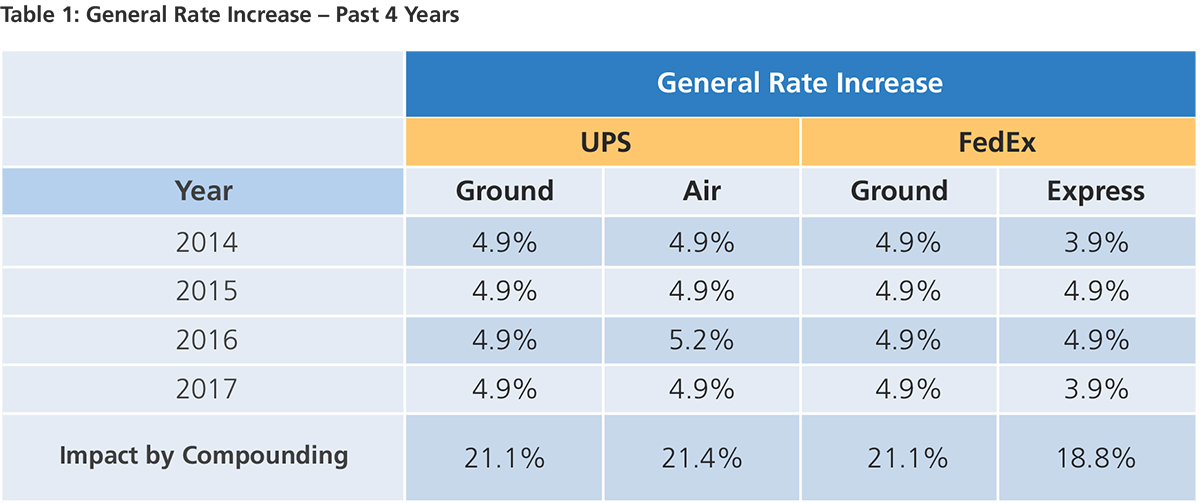
Over a period of time, these small (and consistent) changes have added up, which will eventually impact your small-package costs significantly. Data from the past four years reveals an increase of almost 21 percent to aggregate freight costs. Further analysis, however, brings to light a slightly different insight. The charts (1-4) and tables (1-3) given ahead are for select service types, but the overall impact for any service type would be similar.
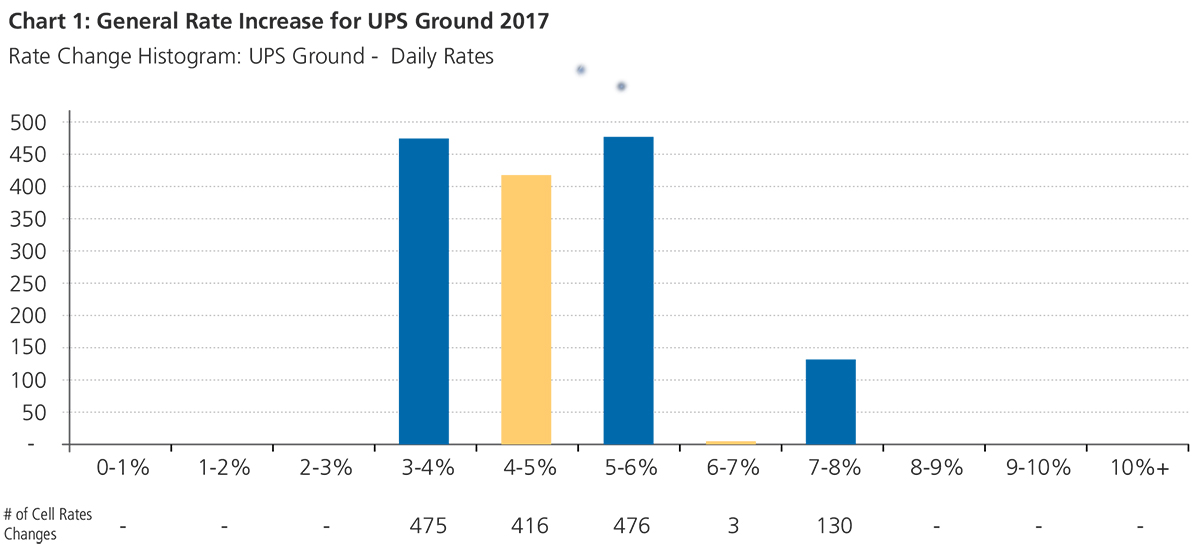
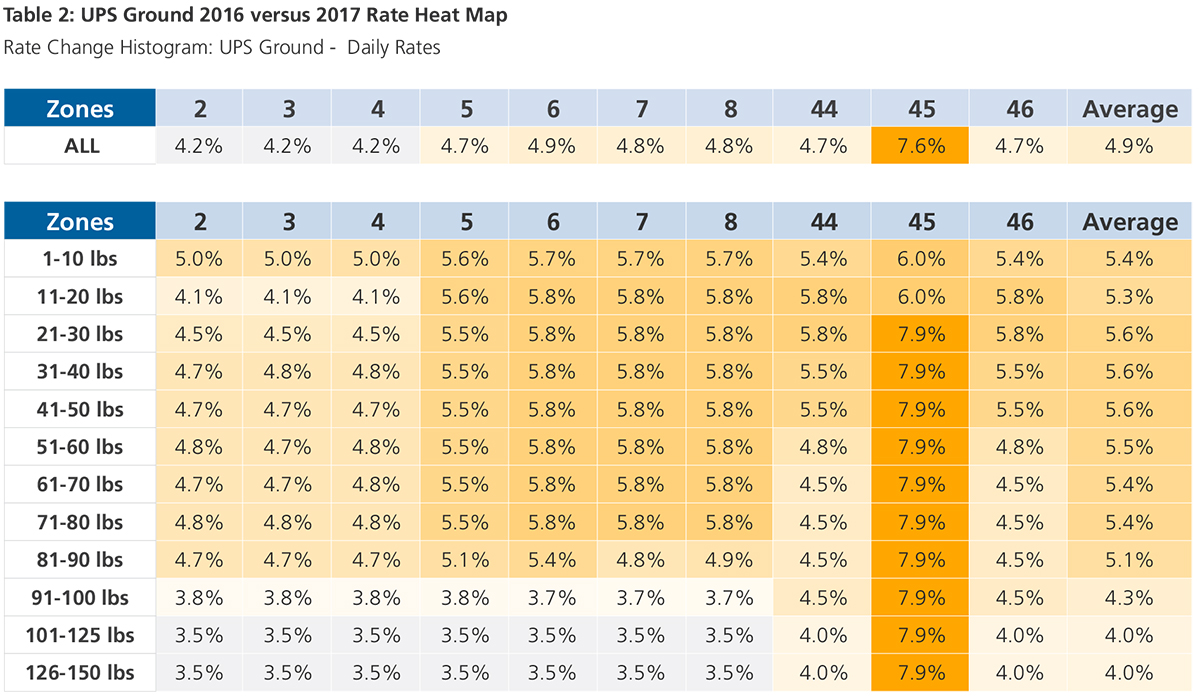
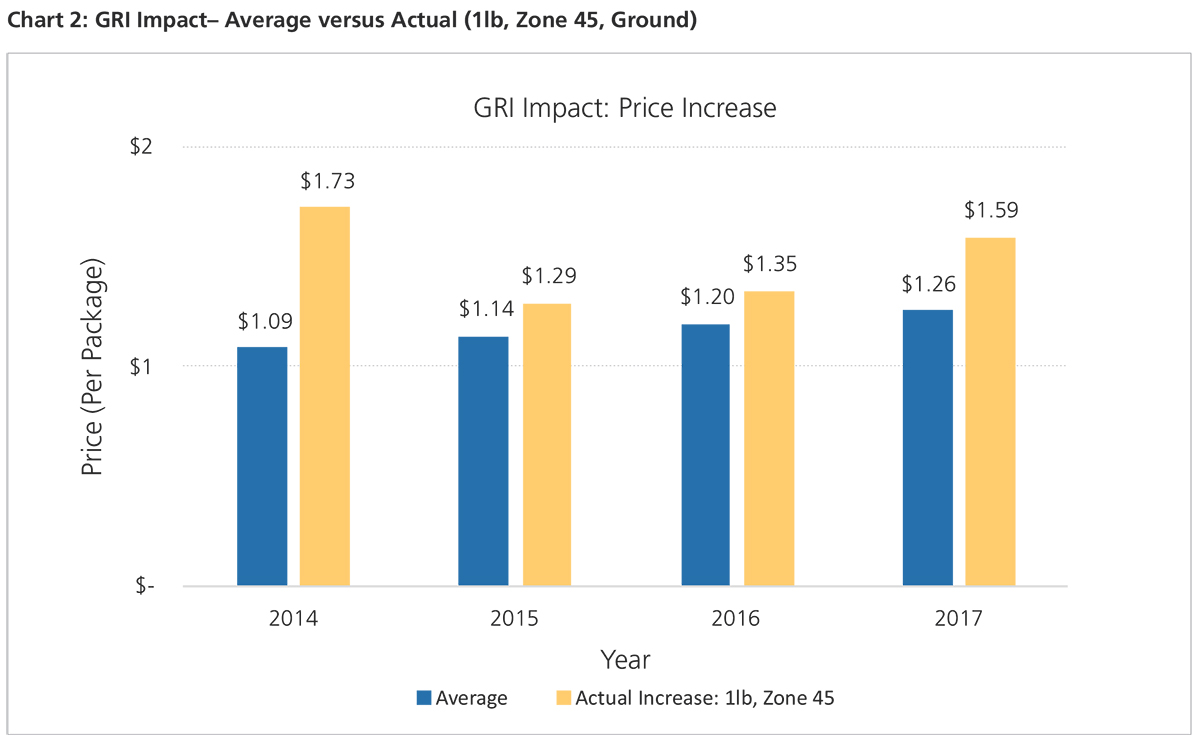
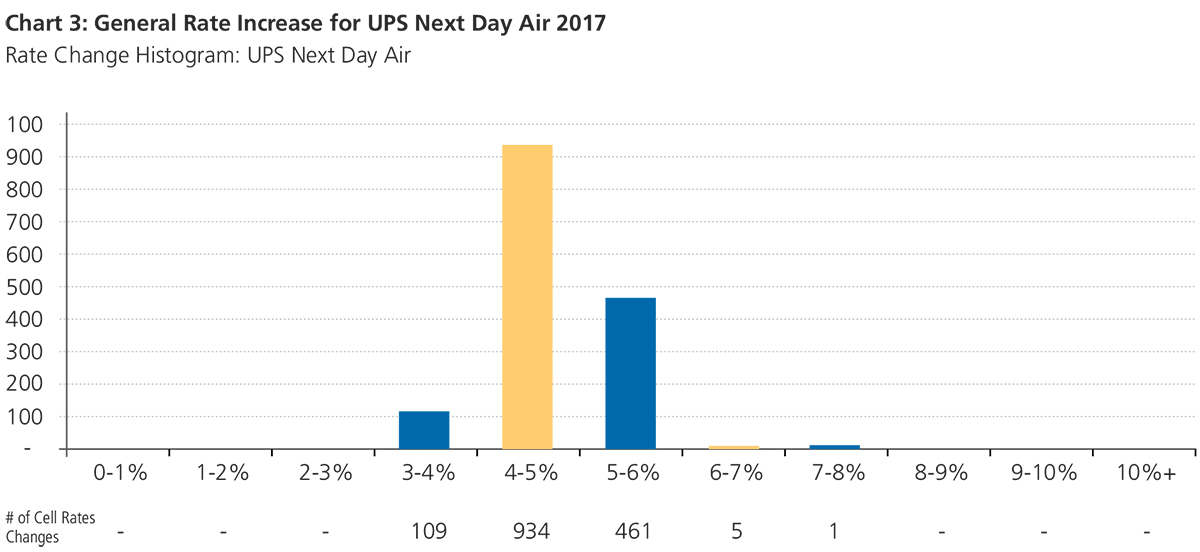
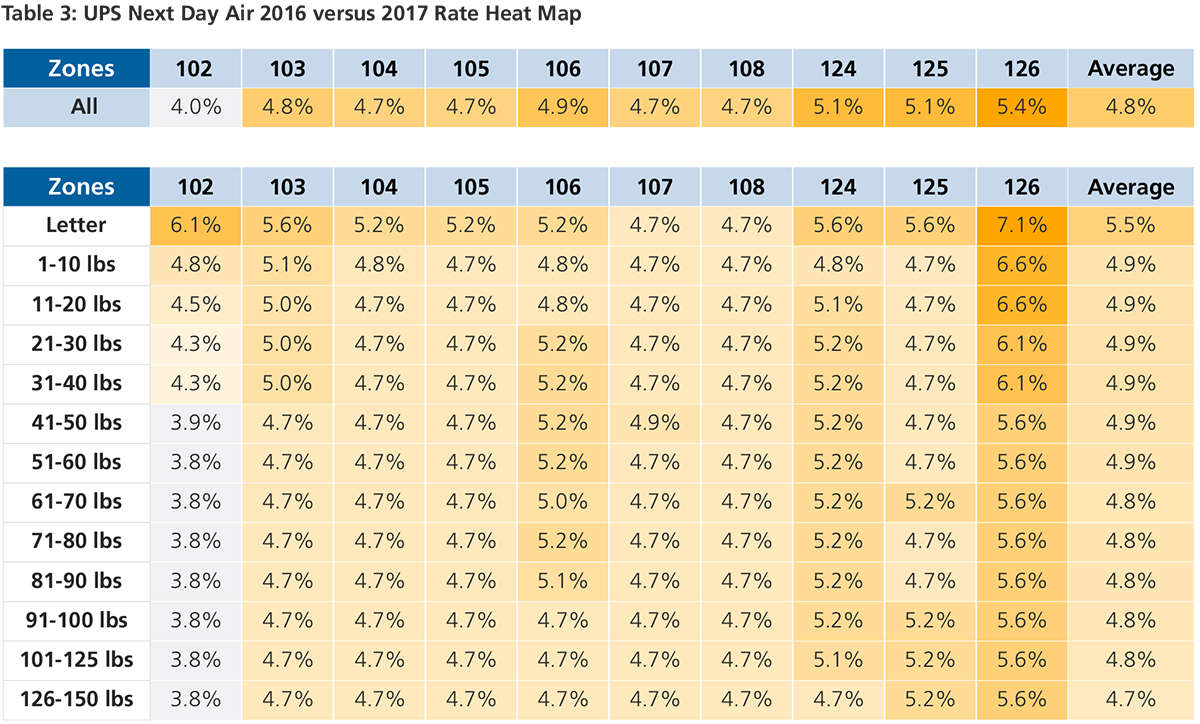
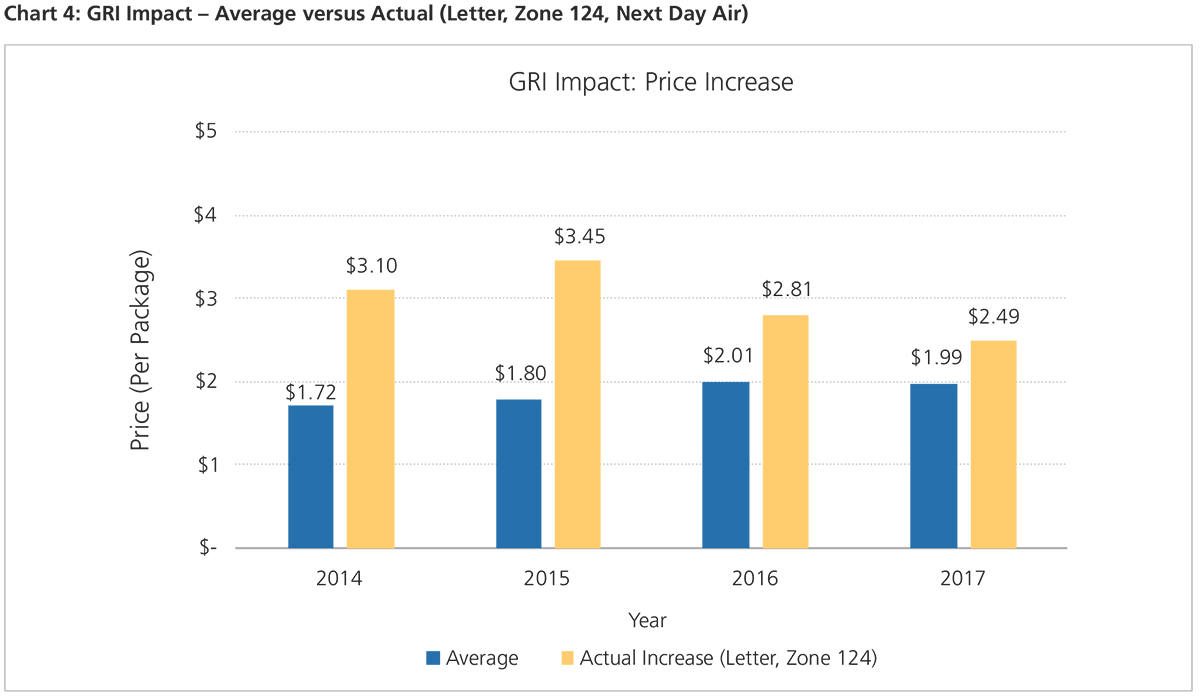
An in-depth review of the rates indicates that GRIs used for marketing purposes by the providers are averages and the net charge differs for each service, weight and zone.
Let’s take a look at some of the changes taking effect this year in ground shipments. The average price increase is 4.9 percent. However, where the shipping profile of an enterprise is heavily dependent on long-range and lightweight ground shipments, the rate increase is higher than the average GRI. If we specifically consider the 1lb ground shipments in zone 45 over the last few years, the prices for these shipments have increased significantly — occasionally increasing by up to 50 percent more than the average GRI. And so we see that marketing information from providers should not be indiscriminately treated as revealing the whole truth, and it is important to dive deeper into the rate tables to really understand how GRIs will affect your company.
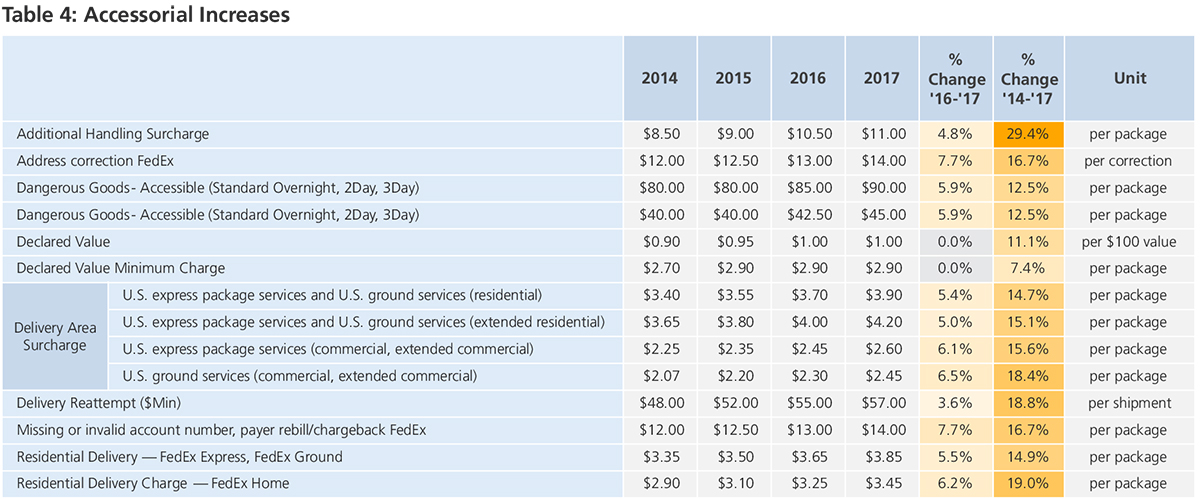
In addition to the GRI in freight prices, carriers also increase accessorial charges, as highlighted in the 2017 accessorial table above. These increases can vary from a moderate 4 percent to as high as 8 percent. While often overlooked, accessorial charges can add appreciably to the overall shipping spend, which makes it even more important to fully understand them.
Declared Value Surcharge
Declared value surcharge is the extra fee paid to insure a package above and beyond the $100 liability that carriers generally provide. Often companies spend a sizable amount insuring their high-value items. However, each company must evaluate a key metric — its net return on investment from buying additional insurance. Many companies end up paying a substantial premium on the additional insurance, which is often not required. Carriers must often deliver a high service level standard as an important yardstick in their contracts — and they generally provide satisfactory service in terms of shipping packages on time, making this a critical parameter for evaluation.
Understanding Carrier Changes and Underlying Strategies
Minimum Charges – These are normally part of your service agreement with your provider and indicate the minimum price that will be charged for each package, regardless of the size or weight of the package. Carriers ensure they make a profit for each package by levying this charge. Over the last six years, the minimum charge has steadily increased each year. Although they don’t have much impact on companies that ship heavy but small parcel packages, minimum charges do materially hurt companies that ship many low-weight parcels during billing. Thus, it is important to negotiate on the minimum charge directly, or work around the problem by bundling multiple smaller pieces together and making the minimum charge non-applicable.
Oversize and Dimensional (DIM) Freight Charges – Carriers have increased their fees on oversized packages and also introduced a pricing model that is based on dimensional weight. In addition, they have added more services and expanded the range of packages that are affected by these surcharges. Most notably, in 2015, FedEx implemented dimensional charges on all ground shipments, which are built on a new chargeable weight and calculated based on the package dimensions. While this additional cost would differ for each shipment and its dimensions, it can potentially increase costs by over 40 percent. Table 5 demonstrates the cost impact of dimensional charges.

As reflected in the table, these charges can escalate costs considerably, especially if packages do not fit the carrier’s specifications. Here, a 5 lb package that had historically been shipped from New York City to Buffalo, New York went by ground service at $8.07. With this supplementary factor attached to ground shipments, the carrier will regard this shipment as if it were a 21 lb package for $12.01. Thus, the need to standardize packaging to every shipment’s specifications is highlighted.
This example further illustrates the pressing requirement to negotiate on the DIM factor directly, based on the analysis of the most frequently used package sizes. Standardization not only helps shippers save costs, but also opens up an opportunity to seamlessly bundle shipments and help carriers free up more cargo space.
Accessorial Fees - Carriers have ushered in over 100 variations in fees and accessorials that can be appended to a shipment. The major accessorials are highlighted in Table 4. These charges add thousands of dollars to an enterprise’s logistical spend. For example, in 2016, UPS introduced a third-party fee, which adds 2.5 percent to the total shipment cost when a third party is used. The Delivery Area Surcharge (DAS) is another example. While relatively unknown, this fee is added if a shipment is going to a specific type of address or zip code. For instance, if the destination is a residential address, each shipment will be charged an extra “residential delivery area” fee. While the add-on charge may be minimal per shipment, its impact becomes significant when the annual volume of consignments is analyzed. In essence, there is a multitude of new pricing strategies coming from carriers, and a lack of insight into these charges may hurt customers’ bottom lines.
Offset Rate Increases With Robust Demand Management
Now that this paper has covered the various pricing strategies from carriers and how enterprises should approach them, here are a few specific steps that can help offset carrier rate increases.
Shipment Mode and Delivery Service Optimization
Leading companies continuously manage to optimize their deliveries in two ways. First, by understanding the type of shipments they send, they shift their services to ones that are less expensive. This also means channeling volume into specific delivery tiers or services to increase base discounts for those services. Where possible, they convert discounts offered in non-utilized delivery options into greater discounts in the heavily utilized delivery services. Second, they understand that not every shipment needs to be shipped via air to arrive at its destination on time. By analyzing zones and zip codes, they can greatly reduce spend by shipping via ground without affecting delivery times.
Bundling
This strategy involves shipping packages in bulk. After a certain threshold is met, bulk shipments are sent from one zone to another, before they are sorted and shipped from the last zone individually. To understand whether this strategy is feasible, we look at the patterns in shipments from each origin to destination and their frequency. Specifically, commodities that are not critical to operations can leverage this strategy effectively.
Billing Code Access
Companies must review who has access to their small parcel billing codes and when they are used. Misuse of the company’s billing code to send a birthday gift to a relative or expenses for repayment is a fairly common occurrence. Ex-employees and companies that have been sold or otherwise spun off are other possible pathways for misappropriation. Companies must frequently assess and identify blatant violators of general business propriety and eliminate further misuse of such codes.
Consider Shipping Alternatives for Residential Addresses
UPS SurePost and FedEx SmartPost are domestic services that utilize the United States Postal Service for the final leg of a shipment’s trip. While FedEx and UPS handle the pickup of the freight and long-haul movements, the final delivery is sorted and handled by the local post office. These services can often generate up to 20 percent savings compared with regular shipments that are handled completely by FedEx or UPS. They also offer Saturday deliveries free of charge. However, a significant potential for delay should be factored in when using USPS and there is greater risk attached to on-time delivery.
But depending on your company’s distribution strategy, it may be prudent to partner with USPS directly; costs can be more than 50 percent lower than partnering with FedEx or UPS, with the option for Saturday deliveries being available. USPS also offers shipments on Sunday in select areas and times.
Clients must look at it from a long-term perspective even as USPS attempts to make investments in two strategic areas. It is making efforts to significantly improve (as in quadruple) its Small Package Sorting System (SPSS) capable service centers. This will provide greater ability for it to process shipments beyond traditional mail. Additionally, USPS recently announced acquisition notices to expand its local delivery fleet. This means mail delivery vehicles running on every street each day could become a thing of the past, as USPS adjusts to the new larger vehicle models.
As mentioned earlier, the service does have its limitations as USPS is currently not structurally set up to handle small packages effectively, given its existing SPSS-capable service centers and its fleet of small Grumman LLVs that are more equipped to handle letters than physical packages. At this point in time, companies may need to be more patient to accommodate and accept USPS as their distribution partner of choice.
Conclusion: Are You Ready to Source Small Parcel?
For many enterprises, the process of sourcing small parcel is exasperating. The significant changes that have taken place in the industry over the years have made the process complex, data-intensive, and generally challenging.
Without proper understanding of these changes, and a well-thought-out solution to tackle them that assigns high priority to the company’s shipping profile, small-parcel spend will become increasingly difficult to contain. By adopting the strategies discussed in this paper, companies can begin to take control of their small-parcel spend and accrue significant savings in the process.

